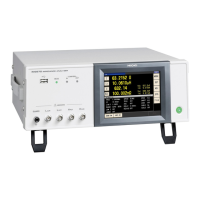7.2 Short Circuit Compensation
280
With short circuit compensation, it is possible to reduce the influence of the residual impedance of the test
cables and thereby to enhance the accuracy of measurement.
It is effective for test samples whose impedance is relatively low.
The comparator decision mode can be set as one of the following:
7.2 Short Circuit Compensation
• Before short circuit compensation, always set the cable length.
See: "7.4 Compensating Measurement Cable Errors (Cable Length Compensation)" (p. 301)
• The measurement accuracy values defined in the specifications are for when open circuit
compensation and short circuit compensation are performed.
• Be sure to perform compensation again after replacing the measuring cable.
You will be unable to obtain correct values if measurement is performed in the compensa-
tion state prior to replacement.
• For spot compensation, short circuit compensation will be valid only when the measure-
ment frequency and spot compensation frequency match.
• When performing compensation, make sure that there is no noise source nearby. Noise
may cause an error when performing compensation.
ex. Servo Motor, switching power source, high-voltage cable and etc.
• For SPOT compensation, the open circuit compensation will be valid only when the mea-
surement frequency agrees with the SPOT compensation frequency.
• The compensated value is preserved in the memory of the main unit even when power is
turned off.
• If the setting of the low Z high accuracy mode is changed, the compensation value
becomes invalid.
All Compensation
Compensation values are obtained for all test frequencies.
Spot Compensation
Compensation values are obtained at the set test frequency only.
OFF
Short circuit compensation data becomes invalid.

